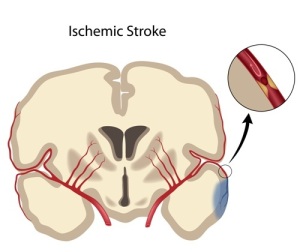Introduction
The most common cause of a stroke is the ischemic stroke. Here is an image of how one of the brain arteries closes off (typically the middle cerebral artery). The end result is a lack of oxygen to the brain in the brain area that is supplied by the middle cerebral artery and is associated with disability typical for such a stroke.
This commonly happens in a patients in their 70’s or 80’s. It is so common that it is the 3rd most common cause of death and it is the 2nd most common neurological disability after Alzheimer’s disease in Western countries.
Symptoms
A stroke commonly occurs in the left middle part of the brain (the left middle cerebral artery), which will affect the right body half (right arm, right leg and right face) with paralyzed muscles. With a right-hand dominant person, the speech center is located on the left hemisphere close to the motor center, so that there will be loss of speech as part of the stroke as well. Sudden severe headaches often occur as well. Partial blindness in a typical, but complicated pattern can appear. If the stroke is big, there can be sudden unconsciousness and there might be a seizure. Even, when conscious, the patient may hear, but may not be able to process what is heard or maybe unable to speak.
Location of brain vessel that causes stroke
The location of the brain vessel, which is closed off determines what kind of stroke symptoms the patient experiences as already stated above with regard to the middle cerebral artery. Closure of the anterior cerebral artery leads to leg weakness and loss of feeling in the skin on one side. Closure of the posterior cerebral artery causes blindness in one eye. The basilar artery at the base of the brain when closed from a clot will lead to acute dizziness, nausea, double vision followed by loss of consciousness. All 4 extremities can suddenly be paralyzed and the patient suffers the “locked-in syndrome”. If the blood supply of the cerebellum is affected, the patient presents with symptoms of ataxia (lack of smooth muscle control), dizziness, vomiting and nausea.
Stroke prognosis
20% of hospitalized patients die in the hospital and this number is usually higher in older patients. Factors that influence the ultimate outcome are age, size and location of the infarct in the brain tissue, general state of health and whether or not there was loss of consciousness at the time of the stroke. A severe mental deterioration, persistent speech loss and persistent brain stem signs are all poor prognostic indicators.
It may be difficult to see, but what is good for your heart is also good for your brain. Prevention of hardening of the arteries will not only prevent heart attacks, but also prevent ischemic strokes (Ref.15).
More than 180,000 nurses were enrolled in two independent Nurses Health Studies and followed between 22 and 30 years. They found that potassium, calcium and magnesium supplementation significantly lowered stroke risk.
Recently researchers have found that a simple blood tests, the C-reactive protein (CRP) can be used to predict whether or not there is a risk of a second ischemic stroke: https://nethealthbook.com/news/blood-test-stroke-risk/
References
1. KH Lee et al. Arch Neurol 2000 Jul 57(7): 1000-1008.
2. S Schmulling et al. Stroke 2000 Jul 31(7): 1552-1554.
3. D Jackson et al. Clin Rehabil 2000 Oct 14(5): 538-547.
4. ML Hackett et al. Neurology 2000 Sep 12; 55 (5): 658-662.
5. K Tsutsumi et al. J Neurosurg 2000 Oct 93( 4): 550-553.
6. IS Spetzler Surg Neurol 2000 Jun 53(6): 530-540.
7. G Lot et al. Acta Neurochir (Wien) 1999; 141(6): 557-562.
8. The Merck Manual, 7th edition, by M. H. Beers et al., Whitehouse Station, N.J., 1999. Chapter 174.
9. Noble: Textbook of Primary Care Medicine, 3rd ed.,2001, Mosby Inc.
10. Ferri: Ferri’s Clinical Advisor: Instant Diagnosis and Treatment, 2004 ed., Copyright © 2004 Mosby, Inc.
11. Rakel: Conn’s Current Therapy 2004, 56th ed., Copyright 2004 Elsevier
12. Ferri: Ferri’s Clinical Advisor 2013, 1st ed. Copyright 2012 Mosby, An Imprint of Elsevier. Acute Ischemic Stroke, Hemorrhagic Stroke and Subarachnoid hemorrhage.
13. Cleveland Clinic: Current Clinical Medicine, 2nd ed. Copyright 2010 Saunders, An Imprint of Elsevier. Section 10. Neurology. Stroke treatment.
14. http://www.ncbi.nlm.nih.gov/pubmed/21911621 : Zhang Y, Tuomilehto J, Jousilahti P, Wang Y, Antikainen R, Hu G. Lifestyle factors on the risks of ischemic and hemorrhagic stroke. Arch Intern Med. 2011 Nov 14;171(20):1811-8. Epub 2011 Sep 12.
15. David Perlmutter, MD: “Grain Brain. The Surprising Truth About Wheat, Carbs, And Sugar-Your Brain’s Silent Killers.” Little, Brown and Company, New York, 2013.







